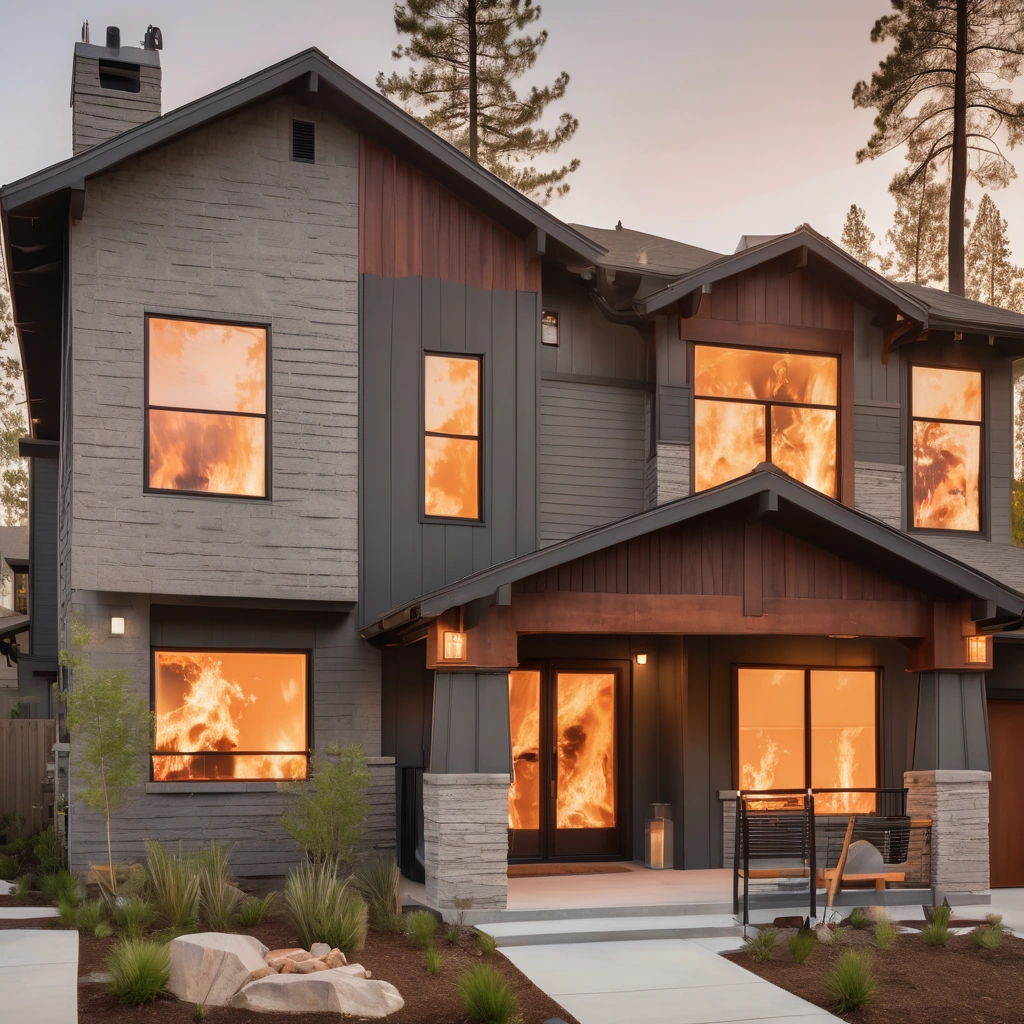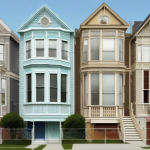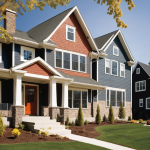Protecting Your California Home: Top 5 Fire-Resistant Siding Options for Wildfire Zones (2025)
Introduction: Fortifying Your Home Against California Wildfires
California’s alluring beauty masks a persistent danger: the ever-present threat of wildfires. For homeowners, safeguarding families and financial futures hinges on proactive measures, with selecting the appropriate siding standing as a primary line of defense. Given the increasing frequency and intensity of California wildfires, understanding the nuances of fire-resistant siding is no longer optional but essential for home protection. This guide serves as a critical resource, delving into the top 5 fire-resistant siding options tailored for California homes in 2025.
We aim to empower you with the knowledge necessary to make informed decisions, fortify your property, and enhance your peace of mind in the face of potential disaster. The selection of appropriate siding options represents a tangible step towards mitigating risk in wildfire-prone areas. Choosing the right fire-rated siding involves understanding the specific challenges posed by California wildfires. Embers, carried by wind, are a major cause of fire spread, often igniting vulnerable parts of a home, including the siding.
Materials with a Class A fire rating offer the highest level of protection, demonstrating superior resistance to flame spread and smoke development. Options like fiber cement siding, known for its durability and aesthetic versatility, and stucco siding, a traditional choice with inherent fire-resistant properties, are popular choices. Metal siding, particularly steel and aluminum, also provides excellent wildfire defense. Understanding the pros and cons of each material is crucial for making a choice that balances fire safety with cost, aesthetics, and maintenance requirements.
Beyond material selection, the effectiveness of fire-resistant siding hinges on proper installation and maintenance. Gaps and joints can become entry points for embers, compromising the fire resistance of the entire wall assembly. Sealing these vulnerabilities with fire-resistant caulk is a critical step. Regular inspections and maintenance, such as cleaning debris from siding and gutters, further enhance home protection. Investing in fire-resistant landscaping around the home’s perimeter can also create a buffer zone, reducing the risk of fire reaching the siding. By taking a holistic approach to fire safety, homeowners can significantly increase their homes’ resilience to California wildfire threats. Prioritizing these measures ensures the longevity and effectiveness of your chosen siding options, ultimately safeguarding your investment and your family’s well-being.
Understanding California’s Wildfire Risk and Building Codes
California’s Building Codes and Wildfire Risk: Understanding the Regulations. California faces a significant wildfire risk, particularly in the Wildland-Urban Interface (WUI), where homes and wildlands meet. This proximity dramatically increases the chance of structures igniting from embers, radiant heat, and direct flame contact during a California wildfire. Consequently, the state has implemented stringent building codes designed to enhance fire safety, particularly concerning exterior building materials. Chapter 7A of the California Building Code (CBC) specifically addresses exterior wildfire exposure and mandates the use of fire-resistant materials, including siding, in WUI zones.
These codes often reference standards like ASTM E84 (surface burning characteristics) and ASTM E119 (fire resistance of building materials) to classify and regulate materials used in construction. Ignoring these regulations can lead to hefty fines and, more importantly, increased vulnerability to fire damage. Homeowners should consult their local building department to determine the specific requirements for their area. For instance, certain regions might require Class A fire-rated siding, while others may have specific requirements for ember resistance.
Understanding the specific requirements for fire-resistant siding options in your area is crucial for home protection. The CBC provides detailed guidelines on acceptable materials and installation methods designed to minimize the risk of ignition and fire spread. For example, fiber cement siding, known for its durability and non-combustible properties, is often a preferred choice in WUI zones and frequently meets Class A fire rating standards. Similarly, stucco siding, when properly applied, offers excellent fire resistance and is another popular choice.
Metal siding, particularly steel and aluminum, also provides a robust barrier against fire, although it’s essential to ensure proper installation to prevent heat transfer. These siding options, when compliant with Chapter 7A, contribute significantly to a home’s overall wildfire defense strategy. Beyond simply choosing fire-rated siding, homeowners should also consider the entire exterior envelope of their homes. This includes paying close attention to details such as the roof, windows, and vents. Using fire-resistant roofing materials, installing dual-pane windows, and equipping vents with ember-resistant screens are all crucial steps in creating a comprehensive wildfire defense system.
Furthermore, maintaining a defensible space around the home by removing vegetation and debris can significantly reduce the risk of ignition. Regular inspections and maintenance of siding, including sealing any cracks or gaps, are also essential to ensure its continued effectiveness. By taking a holistic approach to fire safety, homeowners can greatly increase their chances of protecting their homes and families from the devastating effects of California wildfires. Prioritizing these measures not only enhances home protection but also contributes to community-wide resilience against wildfire threats.
Top 5 Fire-Resistant Siding Options: Pros & Cons Analysis
Fiber Cement Siding (e.g., James Hardie): Pros: Excellent fire resistance (Class A fire rating), durable, resists pests and rot, available in various styles and colors. Cons: Higher initial cost, requires professional installation, can be brittle if not handled carefully. Fire Rating: ASTM E84: Flame spread index of 0, smoke-developed index of 5. Cost (Installed): $10-$15 per square foot. Maintenance: Low; requires occasional cleaning. Aesthetic Considerations: Mimics the look of wood, stucco, or masonry. Fiber cement siding stands out as a premier choice for fire-resistant siding, particularly in California wildfire zones.
Its Class A fire rating signifies the highest level of protection, crucial for homes in high-risk areas. The material’s composition, a blend of cement, sand, and cellulose fibers, contributes to its non-combustible nature, effectively hindering the spread of flames. Furthermore, its resistance to pests and rot ensures long-term durability, making it a worthwhile investment for home protection. While professional installation is generally required, the enhanced safety and longevity it provides often outweigh the initial cost.
Stucco Siding: Pros: Excellent fire resistance, durable, relatively low maintenance. Cons: Can crack over time, limited color options, application can be labor-intensive. Fire Rating: Naturally fire-resistant. Cost (Installed): $8-$12 per square foot. Maintenance: Patching cracks as needed. Aesthetic Considerations: Traditional Southwestern or Mediterranean style. Stucco’s inherent fire resistance makes it a popular siding option in California, particularly in areas embracing Southwestern or Mediterranean architectural styles. Its thick, cement-based composition acts as a natural barrier against fire, providing substantial home protection.
While stucco is naturally fire-resistant, proper application is crucial; thickness and correct mixing ratios are essential for optimal performance. Although it can develop cracks over time due to seismic activity or ground settling, these are typically manageable with routine maintenance. The relatively lower cost compared to some other fire-rated siding options also adds to its appeal for homeowners seeking a balance of affordability and wildfire defense. Metal Siding (e.g., steel, aluminum): Pros: Non-combustible, durable, lightweight, recyclable.
Cons: Can dent, may require specialized installation, can be noisy during rain. Fire Rating: Non-combustible. Cost (Installed): $9-$16 per square foot (steel), $7-$13 (aluminum). Maintenance: Minimal; occasional cleaning. Aesthetic Considerations: Modern, industrial look. Product Example: Bridger Steel. Metal siding presents a compelling option for homeowners seeking a modern aesthetic combined with robust fire resistance. Steel and aluminum siding are both non-combustible, meaning they won’t contribute to the spread of fire. This makes them an excellent choice for creating a wildfire defense perimeter around your home.
While aluminum is lighter and more resistant to corrosion, steel offers greater impact resistance. Both materials are recyclable, aligning with environmentally conscious building practices. The potential for dents and noise during rain can be mitigated with proper installation techniques and insulation. With various profiles and finishes available, metal siding offers design flexibility for achieving a contemporary look while prioritizing fire safety. Brick Siding: Pros: Excellent fire resistance, durable, long-lasting. Cons: High initial cost, requires a strong foundation, limited design flexibility.
Fire Rating: Non-combustible. Cost (Installed): $15-$25 per square foot. Maintenance: Very low. Aesthetic Considerations: Classic, traditional look. Brick siding is a time-tested, highly effective choice for fire-resistant siding. Its non-combustible nature provides exceptional fire protection, making it a reliable barrier against California wildfire threats. The sheer mass and density of brick contribute to its ability to withstand intense heat and prevent fire from penetrating the structure. While the initial investment is significant, the longevity and minimal maintenance requirements of brick siding offer long-term value.
The classic aesthetic of brick lends a timeless appeal to any home, although design flexibility may be somewhat limited compared to other siding options. For homeowners prioritizing maximum fire resistance and a traditional aesthetic, brick siding represents a solid, enduring investment. Engineered Wood Siding with Fire Retardants (e.g., LP SmartSide FireSmart): Pros: More affordable than some other options, easier to install than natural wood, treated for fire resistance. Cons: Fire resistance depends on the effectiveness of the treatment, may require more maintenance than other options.
Fire Rating: Often treated to achieve a Class A or B fire rating. Cost (Installed): $7-$12 per square foot. Maintenance: Regular painting or staining. Aesthetic Considerations: Mimics the look of natural wood. Product Example: LP SmartSide FireSmart. Engineered wood siding treated with fire retardants offers a balance of affordability and aesthetic appeal, making it a popular choice for homeowners seeking fire-resistant siding that mimics the look of natural wood. Products like LP SmartSide FireSmart are specifically designed to meet stringent fire safety standards, often achieving a Class A or B fire rating. The effectiveness of the fire retardant treatment is paramount, and homeowners should carefully review product specifications and warranties. While easier to install than natural wood, engineered wood siding typically requires regular painting or staining to maintain its appearance and fire-resistant properties. This option provides a cost-effective way to enhance home protection against California wildfires while achieving a desired aesthetic.
Installation Best Practices for Fire Resistance
Installation Best Practices for Enhanced Fire Resistance: Proper installation is crucial to maximizing the fire resistance of your siding. Key considerations include: Sealing: Seal all gaps and joints with fire-resistant caulk to prevent embers from entering the wall cavity. Flashing: Use metal flashing around windows, doors, and roof intersections to protect vulnerable areas. Underlayment: Install a fire-resistant underlayment beneath the siding to provide an additional layer of protection. Vents: Ensure proper ventilation while using ember-resistant vent screens.
Clearance: Maintain a clear area of at least 6 inches between the bottom of the siding and the ground to prevent ground fires from spreading. Beyond these foundational steps, consider the specific vulnerabilities of your home’s architecture. For instance, eaves are notorious ember traps. Enclosing eaves with fire-resistant materials or installing eave vents with ember blockers can significantly reduce the risk of ignition. Similarly, decks and balconies, often constructed with wood, should be retrofitted with non-combustible decking materials or protected with fire-retardant coatings.
Remember that even the best fire-rated siding, such as fiber cement siding or stucco siding, will be compromised if embers find a way into vulnerable areas. This holistic approach to home protection is essential in California wildfire zones, where wind-driven embers can travel considerable distances. Choosing the right fasteners is also critical. Standard nails or screws can melt or weaken under intense heat, compromising the integrity of the siding installation. Opt for stainless steel or other high-temperature-resistant fasteners that can withstand extreme conditions.
Furthermore, ensure that the siding is installed according to the manufacturer’s specifications, paying close attention to overlapping and fastening patterns. Deviations from these guidelines can create weak points that allow embers to penetrate the wall assembly. Regular inspections of your fire-resistant siding, especially after severe weather events, are crucial for identifying and addressing any potential vulnerabilities. This proactive approach ensures that your wildfire defense remains robust and effective. “Proper installation is just as important as the Class A fire rating of the siding itself,” emphasizes Maria Rodriguez, a licensed contractor specializing in wildfire-resistant construction in Southern California. “I’ve seen countless homes with excellent siding options fail because of shoddy workmanship. Homeowners need to vet their contractors carefully and ensure they have experience with fire-resistant materials and installation techniques.” According to data from the Insurance Institute for Business & Home Safety (IBHS), proper installation can increase the effectiveness of fire-resistant siding by as much as 50%. This underscores the importance of investing in qualified professionals who understand the nuances of wildfire defense and can ensure that your home is adequately protected.
Long-Term Value and ROI of Fire-Resistant Siding
Investing in fire-resistant siding transcends mere home improvement; it’s a strategic decision that safeguards your property and enhances its long-term value, particularly in California’s wildfire-prone regions. While the upfront cost of fire-rated siding, such as fiber cement siding, stucco siding, or metal siding, may exceed that of conventional siding options, the potential savings from preventing fire damage, coupled with reduced insurance premiums, often provide a compelling return on investment. Homeowners must consider the escalating costs associated with wildfire damage, including property loss, displacement, and emotional distress.
Opting for a proactive wildfire defense strategy, starting with Class A fire rating siding, mitigates these risks significantly. Beyond direct cost savings, fire-resistant siding contributes to increased property value. In California, where California wildfire risk is a prominent concern for homebuyers, a home equipped with robust fire protection features commands a premium. Potential buyers recognize the long-term benefits of reduced insurance costs, enhanced safety, and minimized risk of property damage. Furthermore, homes demonstrating proactive fire safety measures are often viewed more favorably during property appraisals.
This is especially true in high-risk areas where lenders and insurers are increasingly scrutinizing home protection measures. By choosing fire-resistant siding options, homeowners enhance their property’s marketability and ensure its lasting value. Moreover, the long-term benefits extend beyond financial considerations. Peace of mind, knowing that your family and home are better protected against the devastating effects of a California wildfire, is invaluable. Selecting the appropriate siding options, coupled with proper installation and ongoing maintenance, forms a critical component of a comprehensive wildfire mitigation plan. This proactive approach not only safeguards your investment but also contributes to the overall resilience of your community.
Expert Quotes: Insights from Professionals
“In high-risk wildfire areas, choosing the right siding is not just about aesthetics; it’s about survival,” says John Smith, a fire safety consultant with over 20 years of experience specializing in California wildfire defense. “Homeowners should prioritize materials with a Class A fire rating and ensure proper installation to create a robust defense against embers and flames. The devastating impact of a California wildfire can be significantly mitigated by selecting appropriate siding options. It’s a critical investment in home protection.”
“We’ve seen firsthand how fire-resistant siding can make a difference,” adds Maria Rodriguez, a local contractor specializing in fire-resistant home construction in wildfire-prone regions. “Proper sealing and flashing are just as important as the material itself. Don’t cut corners on installation. For instance, we recently worked on a home where the owners chose fiber cement siding but neglected to properly seal the joints. During a small brush fire, embers managed to penetrate the wall cavity, causing significant damage that could have been avoided.”
Beyond material selection, understanding the nuances of fire-rated siding installation is paramount. According to a recent study by the Insurance Institute for Business & Home Safety (IBHS), homes with properly installed Class A fire-rated siding, such as stucco siding or certain types of metal siding, have a significantly higher chance of surviving a wildfire. This includes using fire-resistant caulk to seal gaps around windows and doors, as well as employing metal flashing to protect vulnerable areas where the roof meets the walls.
These seemingly small details can make a world of difference in protecting your home. Moreover, homeowners should consider the long-term implications of their siding choice. While the initial cost of fire-resistant siding options might be higher, the potential savings in terms of reduced insurance premiums and avoided fire damage can be substantial. Furthermore, investing in durable, fire-resistant materials like fiber cement siding not only enhances home protection but also increases property value, making it a wise financial decision in the long run. Prioritizing fire safety in home improvement projects is an investment in peace of mind and long-term financial security.
Conclusion: Take Action to Protect Your Home
Protecting your California home from wildfires demands a proactive and informed strategy. By thoroughly understanding the inherent risks associated with California wildfire seasons, diligently adhering to evolving building codes, and strategically selecting the most appropriate fire-resistant siding, you can substantially reduce your property’s vulnerability to devastating fire damage. Remember that the effectiveness of any wildfire defense hinges on proper installation by qualified professionals and consistent maintenance to ensure long-term protection. Don’t delay – the time to act is now, safeguarding not only your home but, more importantly, the well-being of your family.
Consider this: according to the Insurance Information Institute, homes with fire-rated siding, particularly those boasting a Class A fire rating, experience significantly less damage in wildfire events. Exploring various siding options, from the enduring reliability of fiber cement siding like James Hardie to the classic fire resistance of stucco siding and the modern durability of metal siding, is a critical step. Each material offers a unique blend of protection, aesthetics, and cost-effectiveness. Consulting with a qualified contractor can provide tailored insights into the best solution for your specific location and budget, ensuring optimal home protection.
Beyond the immediate safety benefits, investing in fire-resistant siding offers long-term peace of mind and potential financial advantages. Many insurance providers offer reduced premiums for homes equipped with superior wildfire defense measures, recognizing the decreased risk of significant claims. Furthermore, a home featuring fire-resistant siding becomes a more attractive and valuable asset in the California real estate market. Request detailed quotes from local contractors specializing in fire-resistant siding installation, and proactively research available rebates or incentives for implementing wildfire mitigation measures. Taking these steps today will fortify your home against the ever-present threat of California wildfires, ensuring a safer and more secure future.


